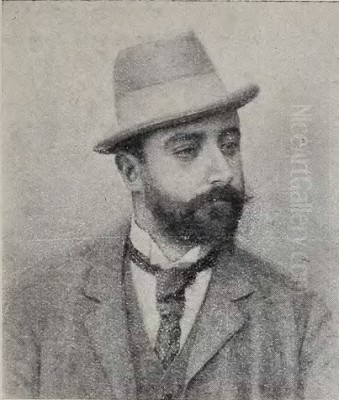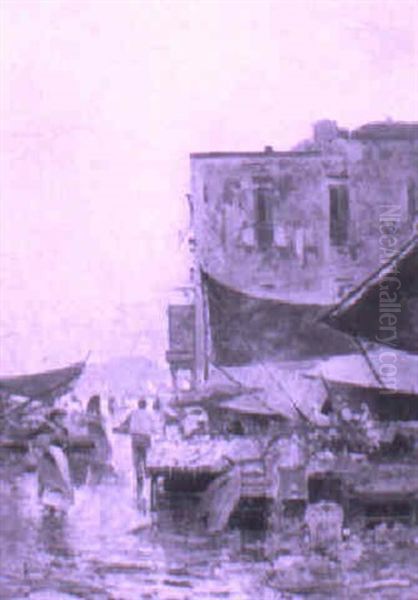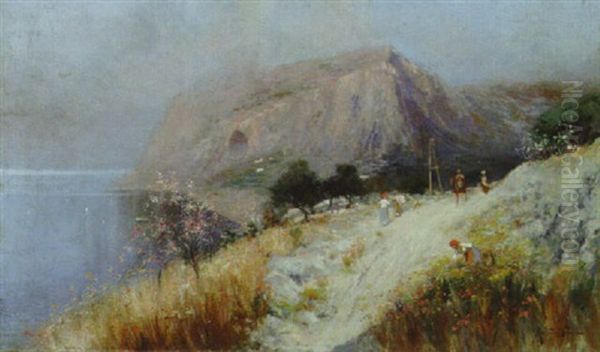
Oscar Ricciardi (1864-1935) stands as a significant figure in the vibrant tapestry of late 19th and early 20th-century Italian art. Born in the sun-drenched city of Naples, Ricciardi dedicated his artistic career primarily to capturing the unique atmosphere, bustling life, and stunning natural beauty of his native region. He emerged during a period of transition in Italian art, navigating the currents of Realism and Impressionism, ultimately forging a style that resonated deeply with collectors both in Italy and abroad. His legacy is tied to his luminous landscapes and seascapes, works that continue to evoke the specific charm and energy of Southern Italy.
Early Life and Artistic Formation in Naples
Oscar Ricciardi was born in Naples in 1864, a city with a rich artistic heritage, particularly renowned for its tradition of landscape painting, famously associated with the earlier Scuola di Posillipo (School of Posillipo). Growing up in this environment undoubtedly shaped his artistic inclinations. The city itself, with its dramatic coastline, the ever-present Vesuvius, and its lively street scenes, offered a wealth of inspiration.
His formal artistic training began under the guidance of Bernardo Celentano (1835-1863), a talented Neapolitan painter known for his historical subjects and realistic style, though Celentano's early death meant this tutelage was likely brief or perhaps Ricciardi studied his methods posthumously. More significant and lasting was the influence of Domenico Morelli (1826-1901), a towering figure in Neapolitan painting and a leading proponent of Italian Realism (Verismo).
Morelli was known for his dramatic historical and religious scenes, characterized by rich color, psychological depth, and a departure from purely academic conventions. While Ricciardi would eventually move away from Morelli's typical subject matter, the older master's emphasis on capturing emotional truth, his bold use of color, and his commitment to direct observation likely left a profound mark on the young artist's development. Morelli's studio was a hub of artistic activity, and exposure to his methods and ideas provided a strong foundation for Ricciardi.
A Shift Towards Landscape and Marine Painting

While initial information suggests Ricciardi may have first explored genre scenes – depictions of everyday life – his mature work and lasting reputation are built upon his dedication to landscape and marine painting. This shift reflects both a personal inclination and a broader trend in Neapolitan art, which had long celebrated the picturesque qualities of the surrounding region.
The Bay of Naples, the Amalfi Coast, the islands of Capri and Ischia, and the imposing silhouette of Mount Vesuvius became Ricciardi's enduring subjects. He was drawn to the interplay of light and water, the vibrant colours of the Mediterranean coast, and the daily activities of the people who inhabited these landscapes, particularly fishermen and market vendors.
His approach moved beyond the purely topographical depictions of the earlier Posillipo School, associated with artists like Giacinto Gigante (1806-1876). While maintaining a commitment to realistic representation, Ricciardi infused his scenes with a greater sense of immediacy and atmospheric vibrancy, reflecting the influence of newer artistic currents, including aspects of Impressionism, though adapted to a distinctly Italian sensibility. His focus became capturing the impression of a place, its specific light and mood, rather than just its physical features.
Style and Technique: Capturing Southern Light
Oscar Ricciardi's style is characterized by its vibrant palette, lively brushwork, and remarkable ability to capture the intense, often hazy, light of Southern Italy. His paintings are often bathed in sunlight, with strong contrasts between light and shadow, particularly in his coastal scenes where the reflection of the sun on the water is a recurring motif.
His use of color was bold and expressive. He employed rich blues for the sea and sky, warm ochres and terracottas for buildings and earth, and bright accents to depict figures, boats, or market wares. This vibrancy contributes significantly to the lively and optimistic feel of many of his works. While influenced by the realism of Morelli, Ricciardi's application of paint often became looser and more gestural, particularly in his later works.

This technique, sometimes described as Impressionistic, involved visible brushstrokes that convey energy and movement. However, unlike French Impressionism, which often dissolved form in favour of capturing fleeting light effects, Ricciardi generally maintained a stronger sense of structure and solidity in his compositions. His work aligns more closely with Italian Verismo and the specific strand of Neapolitan painting that sought to capture the 'truth' of local light and life with freshness and immediacy. He excelled at rendering atmospheric effects – the haze of a hot summer day, the clear light after a storm, or the bustling energy of a crowded street.
Notable Works and Recurring Themes
While a definitive catalogue raisonné might be complex to assemble due to his prolific output and commercial focus, several works and themes are representative of Oscar Ricciardi's oeuvre. His coastal views, often titled Veduta costiera or similar, are perhaps his most iconic. These frequently depict the rugged Amalfi coastline, small fishing villages nestled in coves, or panoramic views across the Bay of Naples with Vesuvius looming in the background.
A specific example mentioned is Marina con imbarcazioni e Vesuvio in Lontananza (Marina with boats and Vesuvius in the distance). This title encapsulates a typical Ricciardi subject: a foreground animated by colourful fishing boats, leading the eye across the sparkling water towards the instantly recognizable volcanic peak. These works showcase his skill in rendering water, light reflection, and atmospheric perspective.
Another cited work, Ricordo di Vesuvio (Memory of Vesuvius) from 1884, described as depicting a villa on the volcano's slopes under sunlight, points to his early engagement with landscape. The small panel format suggests it might have been an oil sketch or a study, demonstrating his practice of observing and capturing effects directly from nature.
Market scenes, like the oil painting dated circa 1920 mentioned in the source material, represent another important facet of his work. These paintings capture the vibrant social life of Naples, depicting crowded squares filled with vendors, shoppers, and colourful displays of produce or goods. They allowed Ricciardi to combine his skill in landscape/cityscape with lively figure painting, showcasing the energy and character of his native city. The painting La fortezza di Rovigo (1905) is also mentioned, though its subject (Rovigo, in Northern Italy) seems atypical for the Naples-focused Ricciardi; verification would be needed, but if accurate, it suggests occasional work outside his usual region.
The Neapolitan Context: Contemporaries and Influences
Oscar Ricciardi did not work in isolation. He was part of a thriving Neapolitan art scene during a dynamic period. His teachers, Bernardo Celentano and Domenico Morelli, were central figures. The legacy of the Scuola di Posillipo, with artists like Giacinto Gigante and Filippo Palizzi (1818-1899), provided a strong tradition of landscape painting upon which Ricciardi and his contemporaries built.
Among his contemporaries in Naples, several artists explored similar themes or represented different facets of the local school:
Giuseppe De Nittis (1846-1884): Though achieving international fame, particularly in Paris and London, De Nittis hailed from Barletta (near Naples) and his early work shared an interest in capturing light and modern life, influencing Neapolitan artists.
Federico Rossano (1835-1912): A landscape painter influenced by the Barbizon school and Morelli, known for his atmospheric depictions of the Neapolitan countryside.
Francesco Paolo Michetti (1851-1929): Primarily associated with the Abruzzo region, Michetti was a friend of Morelli and a powerful figure in Italian Verismo, known for his vibrant, large-scale depictions of local life and customs. His work was widely influential.
Antonio Mancini (1852-1930): A highly individualistic figure painter known for his thick impasto and psychologically intense portraits, Mancini was a key member of the Neapolitan school, showcasing a different direction from landscape.
Vincenzo Irolli (1860-1949): Known for his sun-filled genre scenes and depictions of Neapolitan children and family life, often with a bright palette and energetic brushwork similar in spirit to Ricciardi's market scenes.
Giuseppe Casciaro (1861-1941): A prolific landscape painter, particularly known for his pastels, Casciaro captured the Neapolitan scenery with a light touch and sensitivity to atmosphere, sometimes overlapping in subject matter with Ricciardi.
Attilio Pratella (1856-1949): Another prominent painter of Neapolitan views, Pratella specialized in marine subjects, market scenes, and cityscapes, often focusing on the port and coastal life, making him a close contemporary in terms of subject.
Edoardo Dalbono (1841-1915): Influenced by Morelli and the Barbizon school, Dalbono painted historical subjects but also highly regarded Neapolitan landscapes and seascapes, known for their poetic quality.
This constellation of artists, along with others like Vincenzo Caprile (1856-1936) and Luca Postiglione (1876-1936), created a rich artistic milieu. While competition undoubtedly existed, there was also a shared interest in representing their region, often exhibiting together in local venues like the Società Promotrice di Belle Arti (Society for the Promotion of Fine Arts) in Naples.
Exhibitions and Recognition
Oscar Ricciardi was a regular participant in exhibitions in Naples, showcasing his work to local audiences and patrons. His paintings, particularly the landscapes and seascapes that captured the popular imagination with their bright colours and appealing subjects, found considerable commercial success.
His works were not only sold within Italy but also found their way into collections abroad. This international reach speaks to the universal appeal of his depictions of the Italian landscape and the effectiveness of his style in conveying the beauty and atmosphere of the region. While perhaps not achieving the same level of critical acclaim or influence as his teacher Morelli or the internationally renowned De Nittis, Ricciardi carved out a successful career and gained significant recognition during his lifetime as a skilled and popular painter of Neapolitan views. His ability to consistently produce attractive, well-executed paintings ensured a steady demand for his work.
Legacy and Place in Art History
Oscar Ricciardi died in Naples in 1935. His legacy is that of a dedicated and talented chronicler of the Neapolitan landscape and seascape. He represents a continuation and adaptation of the region's strong tradition of veduta (view) painting, infused with the techniques and sensibilities of late 19th and early 20th-century Realism and Impressionism.
He is best remembered for his ability to capture the brilliant light and vibrant atmosphere of Southern Italy. His paintings, filled with sun, sea, and the lively presence of local people, offer an enduring vision of Naples and its surroundings during his era. While part of a larger group of Neapolitan artists exploring similar themes, Ricciardi developed a recognizable style characterized by bright colours and energetic brushwork that proved highly popular.
His work continues to be appreciated by collectors and appears regularly on the art market, often commanding respectable prices, as indicated by the valuation examples provided (€1800-€2500 for Marina con imbarcazioni e Vesuvio and €2000-€2200 for La fortezza di Rovigo). He holds a firm place within the history of the Neapolitan school, representing a successful synthesis of traditional landscape painting with more modern techniques of capturing light and atmosphere.
Conclusion: An Enduring Vision of Naples
Oscar Ricciardi remains an important artist for understanding the Neapolitan school of painting in the decades spanning the turn of the 20th century. Bridging the gap between the academic realism of his predecessors and the burgeoning influences of Impressionism, he created a body of work celebrated for its luminosity, colour, and evocative portrayal of his native region. From bustling market scenes to tranquil coastal vistas under the Mediterranean sun, his paintings offer a compelling and enduring vision of the life and landscapes of Naples and Southern Italy. His commercial success during his lifetime and the continued interest in his work today attest to the lasting appeal of his art.